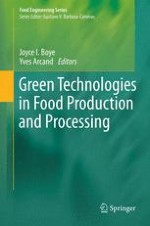2012 | OriginalPaper | Buchkapitel
9. Food transportation issues and reducing carbon footprint
verfasst von : Wayne Wakeland, Susan Cholette, Kumar Venkat
Erschienen in: Green Technologies in Food Production and Processing
Verlag: Springer US
Aktivieren Sie unsere intelligente Suche, um passende Fachinhalte oder Patente zu finden.
Wählen Sie Textabschnitte aus um mit Künstlicher Intelligenz passenden Patente zu finden. powered by
Markieren Sie Textabschnitte, um KI-gestützt weitere passende Inhalte zu finden. powered by
